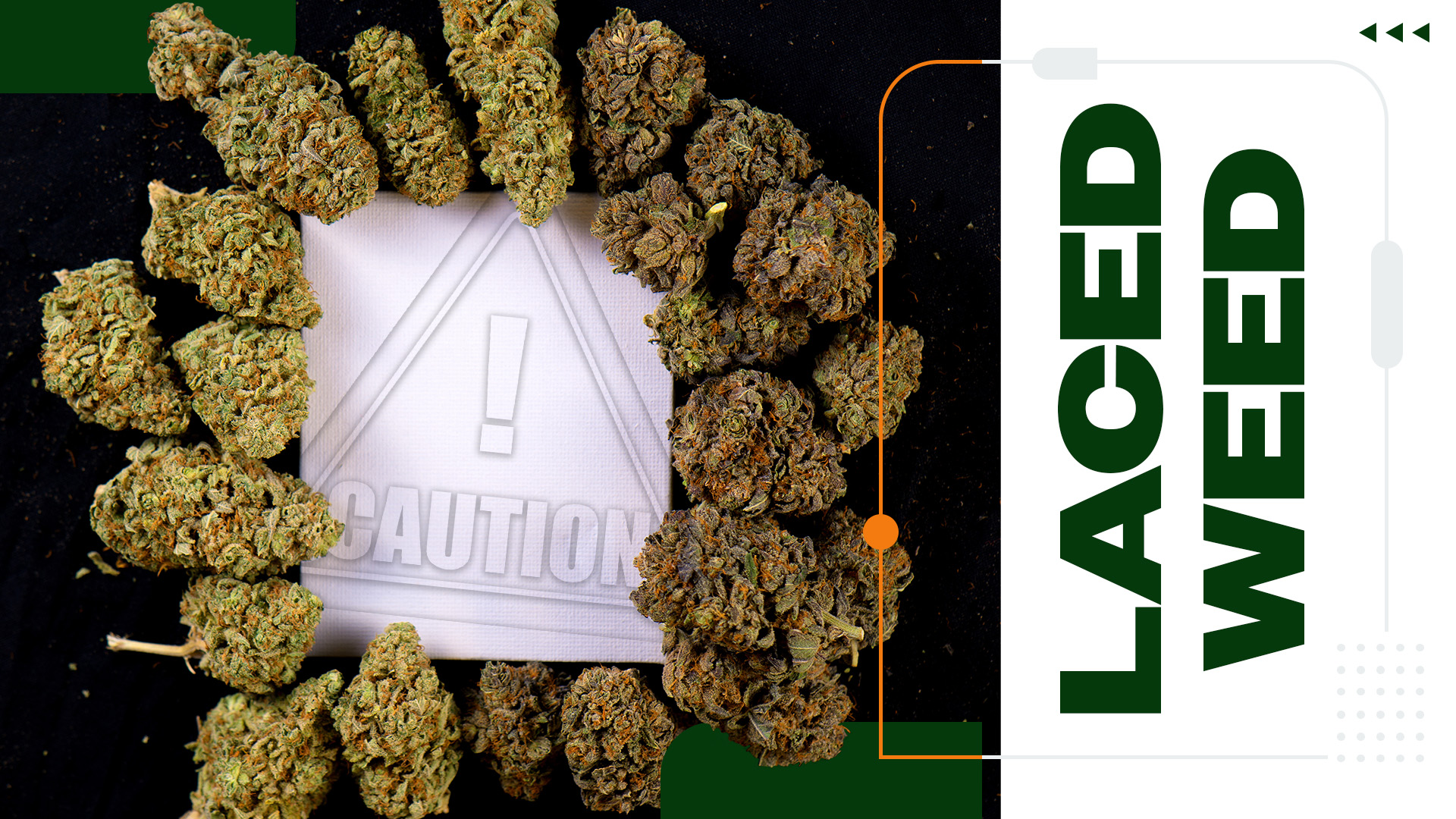On January 25 the Charleston Illinois Police had a really strange
interchange with a guy at a gas station. The guy, a 22-year old student
from Eastern Illinois University, was acting strange and called the
cops about 1:00 a.m. to request help. The young man stated that he
think the weed he had just smoked was maybe laced with PCP. The cops
suggested he move his car away from the gas pump he was blocking. (Kind
of odd suggesting a guy who tells you he is wasted should drive his
car.) The guy then started shaking like a leaf and as a cop approached
him he grabbed the cops gun (they don't have retention holsters in
Illinois?) and shot himself once. He died. No officers were injured
and no additional shots were fired.
In recent years, the allure of marijuana has taken a sinister turn with the rise of laced weed.
Since the disturbing trends of fentanyl and heroin-laced weed took
over, casual users and those struggling with addiction are both in
danger.
Laced weed refers to marijuana that has been adulterated or mixed
with other substances such as fentanyl, heroin, PCP, ketamine, cocaine,
and more. The main intent behind lacing is to enhance or diminish some marijuana effects to create a more potent experience.
In many cases, lacing is done by illegal drug dealers to bulk up their production for more profitability.
In this post, we’ll delve into the concept of laced weed, exploring
what it entails, its dangers, signs of use, health risks, and more.
What Is Laced Weed?
Lacing is a prevalent practice in drug circles, and it’s notably
pervasive among substances like cocaine. The main point behind lacing is
to augment the volume of the original product to maximize
profitability.
This manipulation of the drug’s composition is usually done by adding
some substances that don’t belong to the original drug. Even though
unscrupulous drug dealers use this technique to add weight to their
products, financial gain isn’t the only goal behind lacing.
In some instances, drugs are intentionally laced with other
substances to enhance or modify the psychoactive effects of the original
drug. The adulteration may be aimed towards intensifying or dampening
the inherent effects of the drug.
Generally speaking, marijuana is less prone to intentional lacing
with other psychoactive substances compared to illicit addictive drugs
like cocaine and heroin.
Still, there are many cases where drug dealers add substances to
cannabis, whether to promote certain effects or add weight to the final
product to gain more profit.
Through the past few, numerous reports about laced weed have
circulated. Some reports claimed that weed is laced with PCP, cocaine,
and heroin to maximize the psychoactive effects of marijuana.
Meanwhile, other reports suggested that drug suppliers mix weed with glass and other non-active substances to increase the product’s weight.
Unfortunately, gathering accurate statistics on the intentional
lacing of weed is extremely challenging. Why? Because reliable data is
scarce, and most information comes from news reports.
As cannabis-based products are gaining legal status for medicinal and
recreational purposes in many countries, regulations about their
quality become more stringent. Despite the legal advancements,
purchasing weed is still a huge risk, especially when sourced from
illicit channels.
Drugs Commonly Mixed With Weed
Lacing poses significant health risks and can lead to a wide range of
unpredicted effects. Even though marijuana isn’t often adulterated
compared to other drugs, weed lacing is still a huge risk to casual
users and people struggling with weed addiction.
Here are some drugs that are often mixed with weed:
Synthetic Cannabinoids
Synthetic cannabinoids
are lab-produced chemicals designed to mimic the effects of the main
active constituent of marijuana: THC. The problem with synthetic
cannabinoids is that they produce different effects, so the outcome of
their consumption is unpredictable.
Even though some have medical potential, these substances are often
illicitly produced and distributed. These substances are usually found
in vaping cartridges or added to plant material, and they’re often
referred to as “K2” or “spice.”
Cocaine
Cocaine is another dangerous drug that’s often blended with
marijuana. Individuals mix cocaine with weed intentionally to mitigate
the negative effects of both drugs, such as marijuana’s sedative impact
and cocaine’s stimulation.
Consuming such a combination can lead to dangerous physical and
psychological side effects, considering the inherent dangers and
addictive nature of cocaine.
LSD
LSD is a potent hallucinogenic substance that induces powerful effects even at minimal doses.
Mixing LSD with marijuana shouldn’t yield significant LSD effects
because heat typically destroys LSD. However, individuals find a way to
make LSD work with marijuana by dapping LSD onto the end of the
marijuana cigarette.
This method allows LSD to produce its powerful hallucinogenic
effects, and since it’s a potent drug, even minimal LSD doses can
produce effects that last up to 10-12 hours.
Users often feel high for the entire duration of the effects, but
after they wear off, they experience severe upset, paranoia, and even
suicidal thoughts.
PCP (Phencyclidine)
PCP, or
phencyclidine, is another dissociative drug that’s known to produce
hallucinations, distorted perceptions of reality, and a feeling of
detachment from the environment. When mixed with marijuana, PCP yields
intense and unpredictable psychoactive effects.
PCP-laced weed is often sold under different street names such as super weed, dusted weed, fry, and other names.
The mix is extremely dangerous and can lead to significant effects such as hallucinations,
confusion, delusion, seizures, aggression, suicidal behavior, and
respiratory issues. There’s also a risk of developing serious
neurological conditions and engaging in risky behavior.
Methamphetamine
Methamphetamine,
widely known as crystal meth, is a dangerous and potent CNS stimulant
often abused for its ability to increase the amount of dopamine in the
brain.
When combined with marijuana, meth can produce a wide range of
dangerous effects, such as hallucinations, seizures, and delusions.
When users aren’t aware that their weed is mixed with
methamphetamine, they are at risk of facing fatal consequences because
methamphetamine overdose is common.
Heroin
Many reports indicate that marijuana has been found laced with
heroin. Since heroin is a CNS depressant and marijuana is a relaxant,
the combination results in extremely low heart and breathing rates,
which can be fatal in some cases.
It’s worth noting that heroin is a dangerous substance use that can
have fatal consequences even when taken in small doses, and what more if
taken due to dependency.
Additionally, regular marijuana use for those patients who don’t
consume heroin has a low tolerance to it. This increases the risk of
serious issues and potential overdose when using heroin-wet weed,
leading to marijuana addiction, where medical attention and addiction
treatment is advised.
Ketamine
Some sources report that ketamine, a substance abuse for its sedative effects, is often laced with weed. The mixture combines the dissociative effects of ketamine with the psychoactive properties of marijuana.
What makes this mixture a lot more dangerous is that the anesthetic properties of ketamine
can mask the user’s ability to recognize the intensity of the combined
effects. People who smoke ketamine-laced weed can experience severe
overheating and dehydration.
Embalming Fluid/Formaldehyde
Embalming fluid is a mixture containing formaldehyde that’s used to preserve dead bodies.
Some reports indicate that marijuana is laced with embalming fluid to increase the potency of marijuana.
However, smoking weed laced with embalming fluid can be potentially
fatal and result in serious issues such as memory loss, neurological
damage, delirium, hallucinations, and psychosis.
Laundry Detergent
Some illicit drug dealers mix laundry detergent with marijuana to improve the appearance, smell, and quality of their product.
Even though laundry detergent might not have serious psychoactive
effects, smoking laundry detergent-laced weed can lead to nausea, sore
throat, and difficulty breathing.
Glass
Adding shattered and crushed glass to marijuana is a common practice among some drug dealers to add weight to their products.
Individuals smoking glass-laced weed or using edible marijuana
products containing glass can experience significant respiratory
distress and other serious health complications.
Lead and Heavy Metals
According to a recent study
among a group of more than 7,200 adults, 358 individuals who used
marijuana within 30 days had 27% higher blood lead levels than those who
didn’t smoke weed.
Weed users also had elevated cadmium levels in their blood and urine
samples. Researchers say that these heavy metals are found in marijuana
user’s blood because of the plant’s ability to absorb metals from the
soil.
Heavy metals such as lead and cadmium can easily end up in the human
body, leading to toxic effects. Lead is a toxic metal, and even small
amounts can alter brain development in children, which leads to
behavioral and learning problems.
Moreover, chronic exposure to lead can lead to kidney damage, cardiovascular problems, and elevated blood pressure.
On the other hand, cadmium is on the WHO’s list of human carcinogens. Individuals exposed to cadmium through tobacco smoke are at risk of developing kidney diseases and fragile bones.
What makes smoking weed mixed with heavy metals even more dangerous
is that these metals can stay in the body for years after the exposure
ends.
Fungus and Bacteria
In many cases, marijuana legally sold in states like Colorado
contained high counts of fungus and bacteria. While the addition of
these substances may not be intentional, it shows that the standards of
growing, storing, and selling cannabis are poorly defined.
Inhaling weed containing a high count of bacteria and fungus can lead
to severe health effects. This shows that using weed, even from legal
sources, can be problematic.
Fentanyl
Fentanyl, a powerful synthetic opioid, is a depressant that’s usually mixed with weed for extra psychoactive effects.
Whether the mixing is intentional or not, smoking fentanyl-laced marijuana constitutes polysubstance use, which means having two or more substances in your system simultaneously.
This is extremely dangerous, especially when combining weed and fentanyl. But why, exactly?
As a depressant, fentanyl slows down the body, inducing relaxation,
sleep, and pain relief. Meanwhile, marijuana is primarily a depressant,
but it can act as a stimulant in some cases. Mixing those two substances intensifies the effects and increases the risk of overdose.
The most significant danger lies in the unaware consumption of
fentanyl-laced weed, as it dramatically increases the risk of overdose.
That’s mainly because of the fentanyl’s potency, which is 50 times
stronger than heroin.
Effects of Smoking-Laced Weed
Since marijuana can be laced with a wide range of active and
non-active substances, the effects and symptoms can be unpredictable and
serious. Here are some common signs of consuming laced weed:
Unusual Behavior
Smoking laced weed often results in a series of erratic and unusual behaviors. That includes anxiety, aggression, and paranoia.
Hallucinations and Distorted Perception
Smoking marijuana laced with active substances such as heroin, cocaine, ketamine, and meth can cause vivid hallucinations and distortions in sensory perception. This often leads to dangerous actions and behaviors.
Euphoria or Sedation
Depending on the substance used to lace weed, individuals might
experience stimulating effects such as euphoria. On the other hand,
depressants mixed with marijuana can lead to significant feelings of
lethargy and sedation.
Uncharacteristic Feelings
On top of the substance-specific effects, individuals who smoke laced
weed can experience different general side effects. These effects
include the following:
- Nausea
- Vomiting
- Diarrhea
- Difficulty breathing
- Dizziness and lightheadedness
- Significant changes in heart rate and blood pressure
- Insomnia
- Decreased appetite
- Nervousness and jitteriness
- Hallucinations
- Delusions
- Confusion and disorientation
















/https://static.texastribune.org/media/files/709b4a8192d5cb129b46018bf9b154dc/0710%20CenterPoint%20Hurricane%20JB%20008.jpg)












